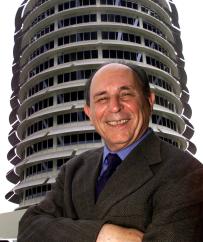The Planning Report shares with deep sadness news of the passing of architect Louis (Lou) Naidorf, at the age of 96 from natural causes. At just 24 years old while working at Welton Becket & Associates, Naidorf designed the Capitol Records Tower, completed in 1956 and celebrated worldwide as the first circular office building and an enduring Los Angeles landmark. His pioneering work helped define the city’s skyline and set a precedent for architectural creativity coupled with practicality. Over his decades-long career, Naidorf’s architectural contributions extended well beyond Hollywood. His portfolio includes the Santa Monica Civic Auditorium, the Beverly Center, the Beverly Hilton, and significant refurbishment of the California State Capitol. These projects reflect a legacy grounded in imagination, structural ingenuity, and civic stewardship. Among those who best knew Naidorf’s spirit of design and dedication to Los Angeles is architect Brenda Levin and her firm, Levin & Associates, themselves central to the preservation and revitalization of the city’s historic fabric. TPR shares with its readers Levin’s own introductory reflections of Naidorf's lasting legacy.

“(Lou) once told me that architecture wasn’t a job you stopped doing; it was a way of seeing the world.” - Brenda Levin, FAIA
I met Lou Naidorf decades ago, at a point in my career when I was eager for mentors who understood not just architecture, but its deeper impact on a city’s soul. He offered guidance and support when I started my fledgling firm in 1980. Being a young architect and a woman in the profession he never hesitated to encourage and champion my success. He was my sponsor for my AIA Fellowship in 1997 and made a drawing to celebrate the occasion of a penguin with a medal around its neck, which is framed and displayed in my office ever since.
Lou was a young man in his twenties when he designed what would become one of the most recognizable silhouettes in Los Angeles: the Capitol Records Building. When he spoke about that tower, it was never just about form or engineering. He talked about buildings as living presences in the city, capable of lifting moods, of sparking wonder, of being good neighbors. And in his hands, architecture was not an abstract exercise but an act of generosity.
Inventing an Icon Before 25
It’s easy to forget how young he was when “Project X” landed on his drafting table — an assignment cloaked in secrecy, offering little more than a location and size. While most would have played it safe, Lou leaned into curiosity and possibility. The circular form he proposed was not a gimmick; it was an invitation to think differently about office space, light, and how a building could interact with the skyline.
That building, of course, would become the Capitol Records Tower, which still rises above Hollywood with a kind of easy optimism. Lou was amused by the theories about its shape, but he cared more that people felt something when they saw it.
A Portfolio that Reached Far and Wide
Lou’s career spanned far beyond one landmark. He gave Los Angeles civic spaces, performance venues, hotels, and commercial centers. He restored historic treasures and shaped skylines in cities across the country. Whether he was working on a state capitol, a sports arena, or a cultural venue, he approached each with the same blend of logic, creativity, and care.
The Teacher and the Gentle Provocateur
In the classroom, Lou was not a lecturer so much as a challenger. He believed an architect’s education wasn’t complete without curiosity about art, science, history, and the world at large. He encouraged his students to understand people — not just as “users” of a building, but as human beings with stories, habits, and dreams.
That attentiveness extended beyond people. Lou was the sort of person who would pause a meeting to help a creature in distress — a bee, a bird, even a snail with a damaged shell — simply because it was the right thing to do. It was the same instinct that guided his design work: to notice, to care, to intervene with purpose.
A Life in Architecture to the Very End
Even long after he could have retired, Lou kept his architecture license active, more out of love for the profession than necessity. He once told me that architecture wasn’t a job you stopped doing; it was a way of seeing the world.
He faced personal loss and health challenges with resilience, and still managed to mentor, to travel, to study, and to imagine new possibilities. In the final years of his life, he remained as engaged in design conversations as he had been in his twenties.
Finishing Thoughts: Lou Naidorf didn’t just design buildings. He shaped the character of cities and the people who live in them. His Capitol Records Building still hums over Hollywood like a timeless refrain, a reminder that architecture can be both functional and joyful.
About a month ago, I chatted with Lou for an hour – reminiscing and laughing. He was quick and funny. I could easily picture his smile and the twinkle of his eyes. I count myself very fortunate to have learned from him, to have shared in his curiosity, and to have seen firsthand how one person’s vision can leave a mark on both a skyline and a generation. He was an inspiration.
- Log in to post comments



